Once upon a time, in the not-too-distant past, all long-distance communication in the US was handled by one company, AT&T. There was no other company that could transmit data over medium to long distances. The breadth and scope of their communications network are not understood by most people these days. Most people know that AT&T handled long-distance telephone calls for the Bell Telephone System until the Bell breakup in 1984. However, AT&T did a lot more than long-distance phone.
For example, if you watched the network news or network TV show anytime before 1980, it was likely brought to you via AT&T microwave system, known as AT&T long lines. Listen to the news on the radio, same deal. Before the widespread use of communication satellites and fiber optics, the AT&T microwave relay network was the only way to get various types of electronic media signals from one place to another.
Beginning in the late 1980s, competing local and long-distance telephone companies began installing fiber optic cables between company offices. That coupled with the increased use of satellite systems for mass media video and audio delivery services made the huge AT&T microwave network obsolete. Some of the old microwave sites that are located in downtown areas have been reused by local phone companies and cell phone providers. Many of the rural sites now sit empty.
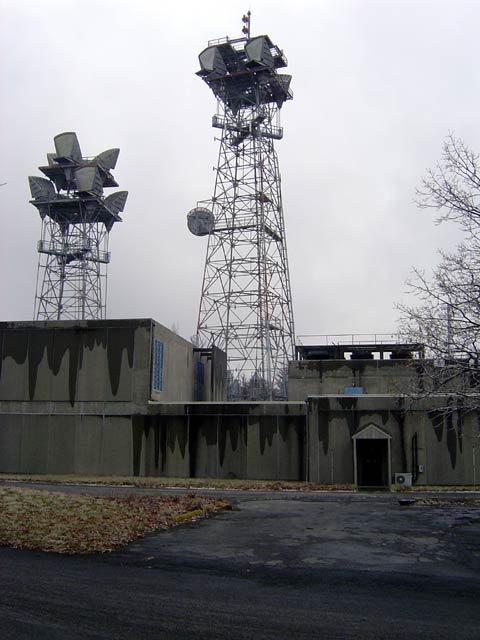
This is the former AT&T microwave relay site located near Kingston, NY. It is now owned by American Tower, Inc. There are two towers behind the building, only the tower on the right has a few active communications antennas on it. The taller tower is 190 feet tall and was built in 1957. The shorter tower is 120 feet tall and was built in 1961. Both towers and everything on them were made by Western Electric, the same company that manufactured the telephone sets. Chances are, Western Electric contracted the actual manufacture of equipment out to others, then billed AT&T, their parent company a markup. Something that would make all MBAs proud.
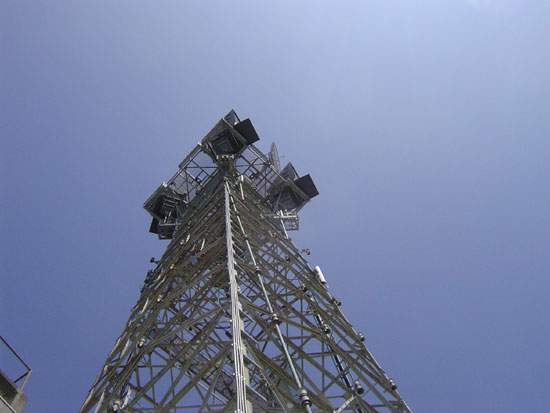
This tower was built in 1957. The structure and galvanizing are still in excellent condition.
The large antennas you see on the towers are microwave horn antennas. They are no longer in use. Several transmitters and receivers would have been connected to each one of these antennas by use of RF multiplexers. Each microwave transmitter/receiver would have had several data channels. Generally, this was C Band microwave equipment, so it was in the 4, 6, and 8 GHz frequency range.
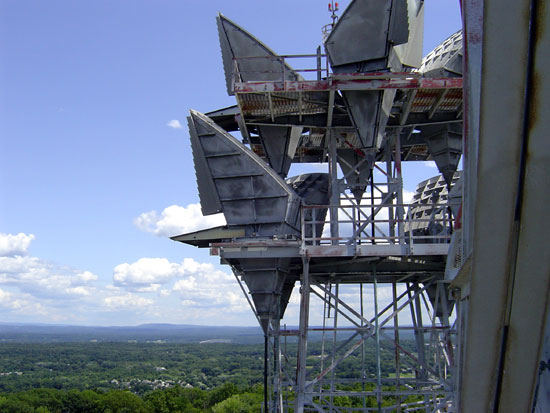
All of this telephone traffic was transmitted on digital data channels unencrypted. Many have argued that this allowed the government (most notably the NSA or National Security Agency) to intercept and listen to most domestic long-distance telephone calls within the US. There is a book called Puzzle palace by James Bamford if you are interested in NSA history. It was written more than 20 years ago, so it doesn’t really apply today, but it is an interesting look at what the government was up to.
The building itself is huge, the first floor is 16,000+ square feet and the second floor is 10,000+ square feet. Only about 1000 square feet of this space is actively being used.
I believe this building was built in the late 1940s or early 1950s, just as Kingston was growing into a major IBM manufacturing site. It has remnants of the ATT coaxial-based system that was used prior to microwaves. The IBM buildings are located a few miles to the southeast of this location, they are another cold war relic for discussion later. The IBM buildings were a major computer research and development site in the 1950s until it closed in 1992. It was assumed that the Soviets had several spy satellites trying to steal secrets from the area, and the IBM facility was a primary nuclear target.
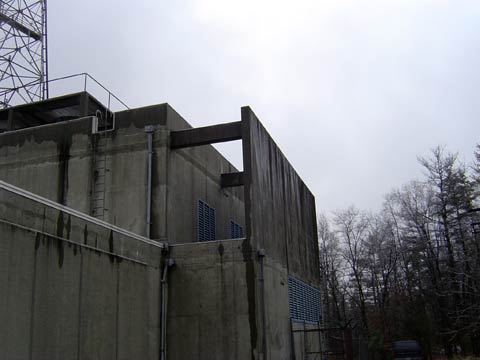
The microwave relay site has 12-inch re-enforced concrete walls. The ventilation air intakes have blast baffles to prevent a pressure wave (from a nuclear explosion) from blowing the ventilation equipment off of its mounts.
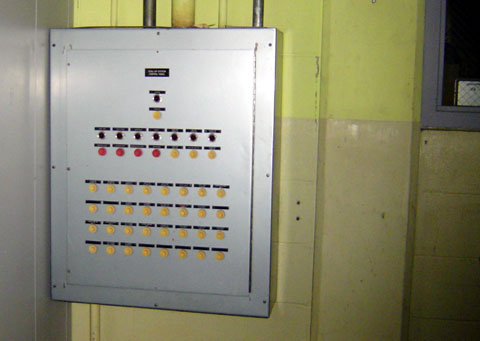
All of the outside openings were able to be sealed with steal blast deflectors using a pneumatic control panel located in the control room. There was a five-minute timer, presumably to allow the HVAC units to be secured before the doors were closed. They were heavy gauge steel shutters designed to deflect the pressure wave of a nuclear explosion. Since this is an earlier building, it is likely that it is built to a 2 PSI pressure wave spec. Newer buildings were built to 20 or even 50 PSI. This microwave relay site would not have withstood a direct hit from a nuclear warhead, especially the higher-yield warheads that came later on.
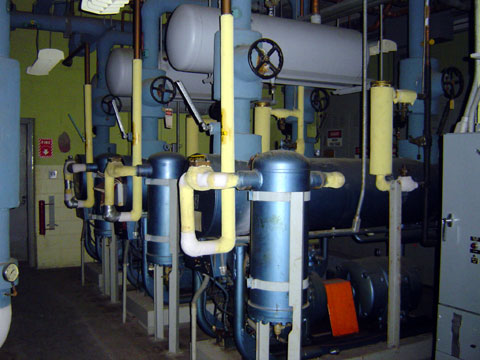
There were three large water chillers to provide cooling to the HVAC units. Since this was the 1950’s all of the electronic equipment would have had tubes, which would have generated a lot of heat while operating. There were two loops in the HVAC system. The refrigerant loop, which ran between these units and the huge condensers on the second-floor roof, and the chilled water loop which ran between these units and the air handlers located in various parts of the building.
There is a bomb shelter in the basement. I found a couple of olive drab cans of civil defense water laying around. The lights were not working at the bottom of the stairs, so I chose not to go into the bomb shelter itself.
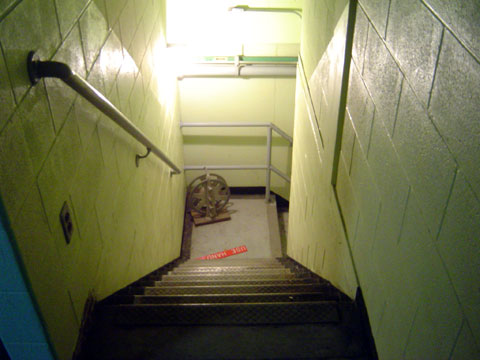
“Okay everybody, the missiles are on their way, so let’s head down these stairs and pray”
There were two diesel generators, one was 325 KW which could run the entire building. The other was a 200 KW which could run the critical building functions. The fuel storage consisted of two 10,000-gallon tanks buried in the ground outside. Each steel fuel tank had a cathodic protection circuit. Basically, a small negative electrical current was passed to the steel tank to keep it from rusting. Apparently, it worked because when the tanks were removed in 2000 after 45 years in the ground, the primer was still on the outside of the tank.
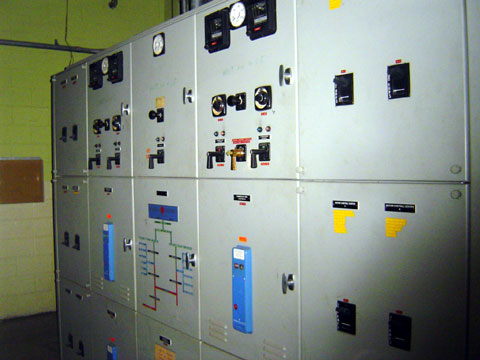
The building has its own power substation. The electricity from the utility company comes off the pole at 13,800 volts and goes to a large step-down transformer on a pad outside. From there 480 volts is fed to this switch panel, where it is routed to motors loads or other step-down transformers within the building.
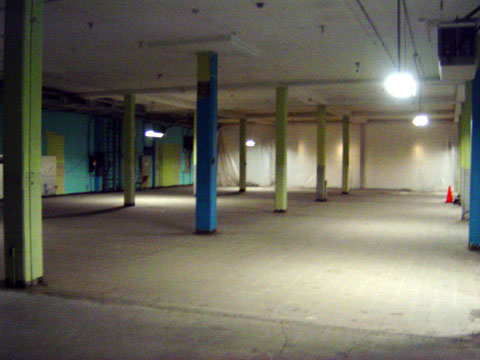
On the main floor, there were rows and rows of wire terminal equipment, microwave transmitters, receivers, and data and RF multiplexers in racks. The room in the above picture is about 10,000 square feet, there is another 6,000 square feet beyond the plastic heat barrier. This microwave gear received and transmitted data from Albany and Germantown to the north; Poughkeepsie, Putnam Valley, Ellenville, and Spring Valley to the south. All of that equipment is gone now, replaced by empty space.
Now the whole place is a little creepy.
There are about 500 copper wire pairs of telephone cables that came into various parts of the building to carry the DS-1 and DS-3 circuits that interfaced with the TELCO office in Kingston.
All in all, this was a serious building, no expense was spared in the construction and equipment outfitting. The entire building is shielded with copper mesh screens embedded in the concrete walls. There were redundant systems on top of redundant systems, something that you do not see these days, even in government buildings such as emergency operation centers (EOCs) and 911 call centers.


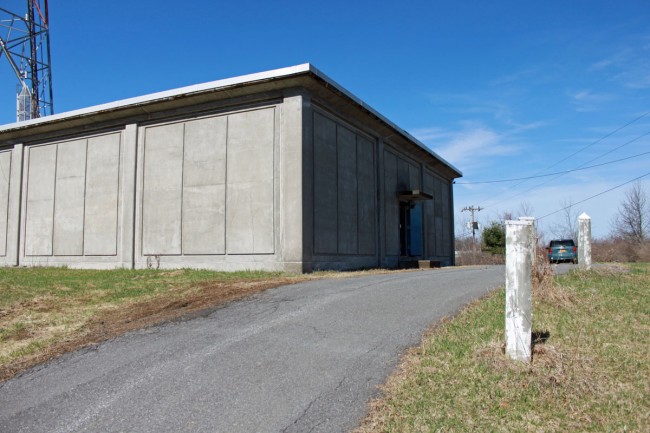
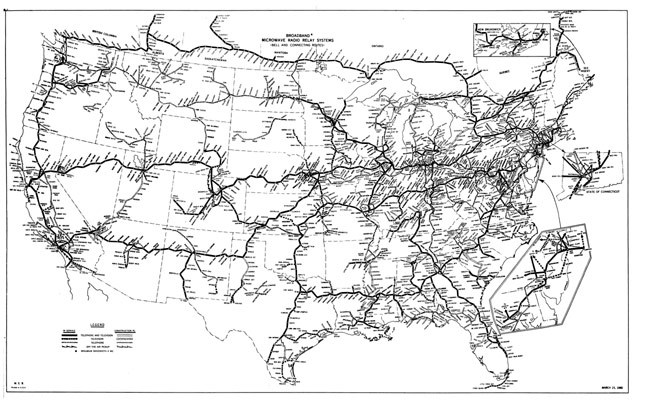
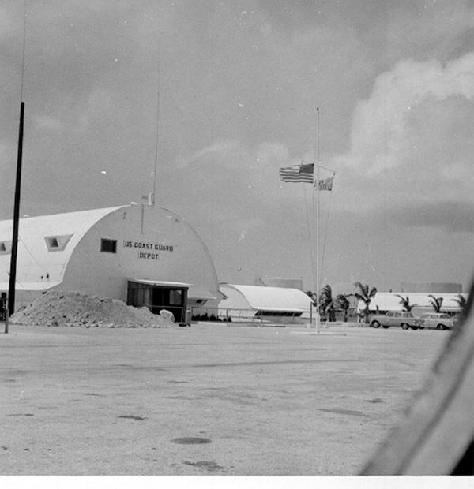
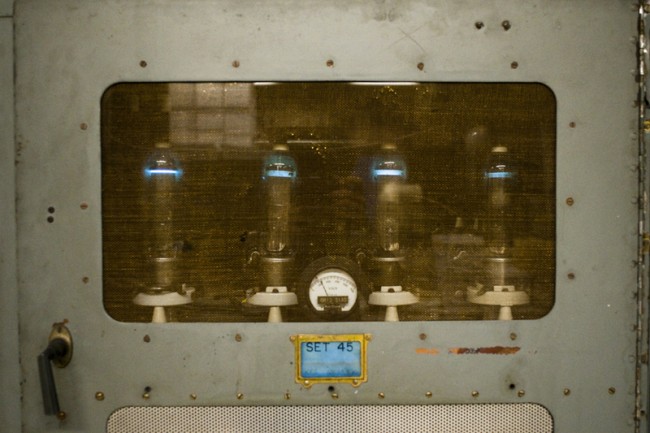
Thank you for that very informative article on that old AT&T microwave horn antenna site. As a kid in the late 60’s I was so intrigued by those towers. We passed a few of them on I-95 between NY and CT. I think this is a great history lesson for anyone to learn not only about electronics but about America. We have one tower here in downtown St. Petersburg, FL that is now used for other things but I can tell that it, at one time, had those large horns.
Keep up the good work.
Regards,
Mark S. Fosella
I happen to own a bunch of these AT&T goodies. What most people don’t realize is that the KS-15676 horns used were broadband 3.6-12 GHz. which in the mid-’50’s when they were developed was something unheard of. The first system was TDX, a short route to prove that the idea was feasible from Boston to New York. Success here led to improvements and the trans-continental TD-2 at 4 GHz. from NJ to San Francisco that carried NBC TV network programs to affiliates. CBS, Dumont, and ABC followed, and by 1955, they were pretty much out of bandwidth. A second parallel route at 6 GHz. (TH-1) ran traveling wave tubes at 12.5 watts out per bank required 10 ton of A/C at each site for cooling. It all came to a screeching halt with their discovery of lasers and fiber-optic technology in 1962. Their competition ran with AT&T’s discovery and beat them to the punch with a pin, while AT&T remained fat, dumb, and happy with the huge revenue stream that was coming in. While AT&T was asleep, others were at work. The SPRINT “pin drop” commercials took AT&T into a frenzy! By 1991, most of the Long-Lines microwave sites were sitting idle, and by 1998 the majority were sold. I bought my first one in 1989 which was one of the dedicated sites to deliver NBC network programming to Channel 3, (later Channel 4). The money that went into building these sites and the network had to be unbelievable! But of course at that time, the United States was a leader in the world, and certainly not what it is today.
Fascinating post.
I always knew that those giant horns were microwave, but I thought they were receive-only, and that some other design was used for send.
A question for J. Aegerter: why do you own one of these sites, if they haven’t been functional for two decades? Parts/scrap? Conversion into condos? 🙂
Thank you for that very informative article on that old AT&T microwave horn antenna site. As a kid in the late 60’s I was so intrigued by those towers. We passed a few of them on I-95 between NY and CT. I think this is a great history lesson for anyone to learn not only about electronics but about America. We have one tower here in downtown St. Petersburg, FL that is now used for other things but I can tell that it, at one time, had those large horns.
Keep up the good work.
Regards,
Mark S. Fosella
Dear KC:
AT&T was a customer of ours at the time and mentioned that de-commissioning of the site was taking place in early 1989, and if I would be interested in purchasing the site to extend our paging range to the south. I purchased it to do just that. However, the deed was not transfered until strict environmental policies on underground tank removal was accomplished by AT&T. It turned out that the underground fuel tank was in near perfect condition, but was removed because AT&T wanted zero liability down the road.
At&T had a cathodic protection system for all of it’s underground tanks at this site. I must have been quite effective, because when the UST was pulled out in 2000, the primer was still on the tank. They could have hosed it off and resold it as new.
Thanks very much for the extremely interesting article. I continue to be fascinated by the history of the Bell System. So much of our American history is woven into the development of telecommunications. I just drove by a large ATT Long Lines tower this past Sunday on I-45 in north Texas near Ennis. I live in Fort Worth and would love to be able to take a peek inside this or another such facility someday, but I don’t have much hope in ever being able to make the right connection (ha ha) to do so. I’d also love to go into an old Bell central office sometime.
By the way, I did a little teaching to my 15 year old son about Long Lines and how they carried long distance telephone and TV, etc. in the “olden days.” He loves it when I use that term. I also knew enough to tell him that these facilities were hardened to be able to withstand a nearby bomb blast during the Cold War. I also told him that old story about how Long Lines did a hurry-up job in 1964 to enable LBJ to conduct some kind of live press conference from the Johnson Ranch in the Texas Hill Country when a head of state was visiting.
Anyone know of a club or group consisting of retired Bell workers and engineers? I’d love to meet some. Also, does anyone have any idea who to contact in the Dallas/Fort Worth area that might be able to get me into a Long Lines tower site and/or an old central office?
Regards to all.
This was an excellent article! These relics of the past fascinate me.
Thanks for this great article. I stumbled on it doing a search. I grew up 15 minutes south of these towers. My dad used to work in this building when I was a young boy and every time we would drive down route 209 approaching Kingston I would always stare at the towers in fascination.
I just spent three days in one of these sites. They still had the TD-2 and TD-3 radios installed! The power had been disconnected so they were not broadcasting. I was amazed at the quality of the craftsmanship with the rigid waveguide and electrical cabling. Another thing I was amazed with was how many spare parts was on hand. I learned a lot from just handling and studying the internals of the waveguide fittings and such.
Truly a remarkable thing to behold.
The site I visited was near Seattle, Washington.
WOW! Thank you for all of this! I have pointed out for years that the site you described here communicated with the old IBM site near Kingston (called Tech City now), and that the tower ther that now houses cell phone apparatus used to have microwave antennas pointed at the ones you provided the excellent photos of. In “The Puzzle Palace” there is a brief blurb that describes IBM testing computers for NSA during the cold war, and this was one of the data links.
I recall seeing this station from the New York State Thruway in July 1973. It was impressive and almost intimidating since I was only 10 years old when I first saw it. I just couldn’t believe the large number of microwave horns that I saw at the time since I never saw such a big microwave relay station in my life at the time. A few years later when I learned that it was truly a microwave relay station, I figured it must have been a very important facility and they simply didn’t want anything of that size too close to New York City since it could be a target. Before that, the largest microwave relay station that I has seen was the one in White Plains, New York. The Halihan Hill (Kingston, New York) former AT&T microwave relay station still intrigues me to this very day simply due to its impressive array of microwave relay antenna.
I toured on of these sites which can still be seen from the Sunshine State Parkway near Ocoee, Florida (that’s near Orlando) when I was a teenager in the 1960’s (a friends dad worked there). Toured it again later after one of the two generators was removed in the 1970’s. It is now primarily a secure records storage facility for business customers. There are cell antennas added to the towers now with the usual cell shacks at the base of the tower. There is also a what looks like a Hustler vertical amateur hf antenna mounted at ground level. There is another on State Highway 50 between Orlando and Brooksville near a place called Tarrytown. I saw another on a trip to Miami several years ago from the turnpike again I think. They are certainly impressive.
Can anyone comment on any possibility of ground water contamination around these sites and what components used that might be of concern. We live near a tower that was actually just removed(last week) by its owner American Tower. Here’s a link to the tower on AT’s site: http://www.americantower.com/SiteLocator/SiteBrochure.aspx?lngSiteId=543&country=united%20states&towernumber=88033 I’ve not found any info on-line about c ground water contamination, but there are rumors here about de-foliants, bcb’s, and generally about cancer rates in proximity to the site. Any thoughts or info are appreciated.
Brian
Brian,
I did the actual erection as an ironworker on this type tower for 8 years back in the 60s and early 70s. The buildings ( installed equipment completed ) are the same as if they were in downtown NYC or in the midddle of the desert in California. I see no reason for you to be concerned as for contaminated water. If you have anymore questions feel free to contact me. neelygotgame at aol dot com
Joe
PS: I was on this site only to show my grand children what kind of work I did when I was in my 20s and nuts. lol
The former IBM site in Kingston had two MW antennas aimed toward the Hallihan Hill MW relays. IBM Kingston is mentioned in “The Puzzle Palace” and this may be a nice area to research the relationship between the “cold war” NSA, IBM, and AT&T.
As a Kingston native, I toured this site in the early 70’s when it was in full operation. Kind of got a behind-the-seens view as I was with a friend that worked there so spent a Sunday afternoon wandering around. At that time, the generator room, on the lower level was half generators (2) and the other half batteries since all of the radio and switching equipment ran on those batteries which were continually being charged. The second or upper floor was off limits as it then contained a bunch of classified equipment linked to the nearby IBM site via microwave. Site was also linked to the NY Telephone CO in downtown Kingston plus it’s main links mentioned above.
Western Union was actually the first to build commercial inter-city microwave links beginning in the mid 1940’s and maintained a similar network. Many of the sites have been converted to other uses or abandoned altogether as you describe here. We have a former Western Union tower close by me on Wisconsin Ave in Washington, DC with the name “WESTERN UNION” still proudly engraved on the transmitter building.
Excellent page! I remember looking at these towers for years as I was growing up nearby… Years ago, The IBM site near Kingston had a pair of microwave dishes that obviously were aimed at them… now, the former IBM tower has only one small, modern dish pointed that way with its mate on Hallihan Hill being of similar size, and the rest of the IBM tower has been relegated to cell phone antennas… The Hallihan Hill arrays remain to this day as attention grabbers if you are driving through the area up the NYS Thruway or US Route 209, even if they are not used anymore….
Information on SAGE and IBM Kingston can be found here: http://www-03.ibm.com/ibm/history/ibm100/us/en/icons/sage/
I live near the Wolf Creek site in Northern California. It’s owned by American Tower now, but it’s in ‘abandoned’ condition. Still has all the horns, but almost all of the waveguide is gone, as is all the equipment in the 10,000+ sq. ft. building. This was a switching center from points east to/from CA and the west coast, and had five paths.
It’s become a teen hangout, since you can take steep-stairs up the tower for a great panoramic sunset view, and you can explore the dark, windowless building.
Last weekend my sons and I visited the Mt. Rose site on mountain bikes. This one is very well-preserved, as it’s above 10,000 feet at one of two Sierra Nevada crossings. It has an aerial tramway from about 400 ft. below for midwinter access through the snow. Site is still in use for the myriad other antennas on it, and has a webcam on it pointed toward Lake Tahoe (with aptly named Relay Peak in the way). Google ‘Tahoe Meadows Webcam’.
Jim, I too live near Wolf Creek. It is a fantastic accomplishment of the past. I would really like to see inside.
The trip to Mt. Rose sounds great. I may need to do that next summer.
Thanks for the comments.
Thank you for this great article. I grew up 1 mile from this site in Rosendale. This site is in Maple Hill. My older brother and I delivered papers to this site and were fascinated by the massive steel door the men would open to get the paper from us. I never really knew the whole story on this building or what they did behind the big door. When you were driving from Kingston to Rosendale you could see the towers and they looked like Mickey Mouse ears. When ever we would give directions to people to get to our house , we would say once you see the Mickey Mouse ears go 1 mile on the left and that was our house. Thanks for the memories. I will be forwarding this to my older brother.
Paul
Don’s mention of classified equipment in the upper floor of the building being connected via microwave link to IBM ties in nicely with the post mentioning “The Puzzle Palace”. This would be an ideal research project for a Cold War Historian IMHO… IBM Kingston was also heavily involved in the SAGE defense system and if I were a betting man, I would bet that SAGE, NSA, AT&T, and IBM all tie together somehow here… If I had the time and resources, I would LOVE to research this!!!
I often require parts for the AT&T DR11-135 and DR6-135 microwave radios. Please contact me if you have any.
When I was about 8 years old, my uncle Nick – always good for a tall tale or crazy fable – told me he once saw a flock of ducks fly in front of the horn antennas near Fulton Ave in Hempstead, NY (gone now), and the microwaves cooked them instantly before they fell to the ground.
Being the age I was and raised on both Tex Avery and Popeye cartoons, it was easy to visualize a quacking duck suddenly vanishing in a bright white flash, then plummeting to the earth … golden brown, fully dressed & roasted, AND on a platter, ready for serving. Naturally I was more horrified than amused.
You suck, Uncle Nick.
I am glad to know that I was not the only young boy who looked upon the microwave relay sites with wonder and amazement. As a young boy growing up in the 1960’s I remember with fondness the exhibits at the Oklahoma state fair. The bell system had a Western Electric plant in town, which always made for a great exhibit. The films the had about the gateway to the future theme and the futuristic music made it all so cutting age, space age and the stuff of dreams. Thanks for the article!
-Wesley Horton
I live south of Washington DC. There are stations on Bryans Road, one near Andrews Air force Base, one in Bel-Alton, and my favorite one is a double tower located in Waldorf, MD.
The stations in Bryans road and Andrews were both stripped of their horns. I grew up with the horns in Waldorf. The station was completely full of horns until September of 2013. I had gone on a trip for a few days and came back to see that the main tower had only 3 horns left. (The second tower has 2 horns). Honestly I am saddened that they were stripped. This leaves the only other tower that I know of that is still for the most part filled. The one at Bel-Alton. I had taken pictures of that station, not knowing what would happen to it.
A few days ago I had driven past it. The tower in Bel-Alton was still holding all of its Reflectors.
Two days later I drove past it and the entire tower was stripped of its horns! I have been hoping that they would put horns back on the Waldorf site, bUT the more I look into horn reflector towers, the more saddened by the whole thing. I guess the good thing is I can say that even though I was born in 1995, I have been alive to see a lot of the old technology. Even if it is phasing out each day.
I would LOVE to get to go onto one of those towers and to be close to the horns. I know it will never happen, but I would be very happy if I were given the opportunity.
If anyone knows more about the towers in general, I would LOVE TO KNOW!
stumbled across this site very interesting, i was looking for an old tower drawing that showed the weights of the old 4 legged tower, does anyone know if drawings still exist?
When I was in High School electronics class, in the spring of 1974 my electronics instructor arranged for me to have my “personal field trip” in one of these microwave tower buildings. So in 11th grade electronics I worked one day on an RF multiplexer/demultiplexer with one of their employees. Great fun!
It’s odd to think of this as a bygone era, but the kids really don’t seem to identify with it. It’s definitely not part of their thinking anymore.
Since 2008 i decided to archive whatever info i can find about AT&T Long Lines Network…
panoramio is a mapping site to showcase pictures from around the world.. For educational purposes i decided to upload and map out Past & Present Communication Networks and other various technology related projects…
You can learn far more about the AT&T Long Lines system at http://long-lines.net where many of us contribute photos and data. There is also an active Yahoo group: ColdWarComms. Join us.
Kingston was a major station, as seen by its size and twin towers. Its licenses were KEE58 & KEM47, an maybe more.
Re: Victor’s remarks; Pomonkey is in Bryans Road, and relayed traffic from Faulkner to the big CO in SW DC. Waldorf is a very important hub, still running many things.
I have been to this building and many like it, and they are unfortunately the stoic remnants of the cradle of today’s communications infrastructure. But not the end of the story.
Much like today, then technology moved along these behemoths couldn’t keep pace with fiber and were turned down, poetically placed on a disposal list and sold off. Their support was a crushing schedule and maintenance compared to the newer equipment was tedious, time consuming and labor intensive. I have visited and worked in many of the buildings, towers, earth stations and cable stations with enough equipment that needs a Red and Blue 20,000 amp DC plant and 5 MW generators to maintain, dwindle to as much equipment you could probably fit in your living room and run with a residential service and a Generac 20kw as back up to include the cooling system.
The new equipment handling is magnitudes larger in bandwidth compared to the old MW towers of yesteryear. The relay towers having been pruned of their horns, repeaters huts and vaults no longer pass along the analog and digital mux to the next station at 1 mile intervals are now filled with water and some cases concrete, wave guides and other services scavenged by opportunistic recyclers or repurposed as mobility towers.
They now have fiber they can throw light greater than 50 miles before regeneration on equipment smaller than as little as 10 years ago. So even the equipment that once replaced these old retired guardians of communications are now finding themselves a home on the ‘disposal list’. As irony would have it, they are now running fiber to support the new mobility at some of these old towers, but these old sites are 20 years too late.
What is more surprising is that some of the sites there are photos of online. The condition of site looks as though time had stopped, trash is still at the same place, lock out tag out tags unmoved, chairs unsat in and curtains still bordering the printed outside view of nature from 50 feet underground.
I have just read all of the above comments and it was like listening to my dad, one of my fondest memories. Thank you all.
My dad was was a phone company man all his life. The phone company magazine did an article on him, calling him a “wizard”. He filmed the opening ceremonial on the Oakland Bay Bridge (1936?); he won a national home movie competition in the 50s; he contacted a member of Admiral Byrd’s expedition to the South Pole on his ham radio; he pointed out to me Sputnik in the night sky from our front yard because he knew exactly where and when to look for it – I think there was a “beeping” signal you could track it with.
He took me to see his workplace a couple of times, at night when he worked the 4-midnite shift. He introduced me to two or three other guys sitting in wheeled chairs in front of a bank of tv screens, keeping tabs on the signal. He showed me the clackity-clacking of the “relay switches”(?) looking like so many tall tiers of library shelves with wires instead of books, accessed by wooden(?) ladders on wheels. Then he took me over to what he, I think facetiously, called the “ticker-tape machine”. Very 50s IBM style.
Then we would take the elevator up to the roof and walk out on the catwalks with cables snaking underneath. He proudly showed me the monster on the roof – the cluster of microwave relay dishes on a metal framework. He taught me the basics of signal transmission and redundancy, being a huge fan of Claude Shannon; he used to mention how he had gone out to Redtop or Bear Mtn to check on the relay stations up in the Sierras. I found your site because I wanted to see those dishes again. What I got was so much more! Thanks again.
My dad was a fun guy to grow up with! I think the best thing he did was spend time with me.
My father Jack Snyder used to work for AT&T Long Lines in Bluffton Ohio. Every day he would go to work as a manager and he would work underground not seeing the light of day until he came out. There was a long flight of steps leading down to the bunker. At the entrance was a door that was about 2 feet thick that would open automatically when you pushed the button. When you entered you first could see a shower station that was to be used to wash off radioactive dust had there been a nuclear blast and you survived. The whole building was pressurized so that air would leak out and not in. I remember the bathrooms had toilets on springs, and the pipes were designed to flex to withstand the shaking from the nuclear blast. The mirrors were made of metal instead of glass so they wouldn’t break. There was a huge panel that showed the status of all the systems in the building. If something was down the light would displayed as orange/red. Most all of the lights were white when my dad showed me the display. There was one button that checked to see if the red lights would come on, and when he pushed it all the lights turned red. He joked that if this is the case, we’re in a heap of trouble. I saw many banks of C-band waveguide with equipment that was buzzing and the room was very warm. The air had to be cooled constantly. I remember the diesel generators to supply electricity if the power grid failed. All in all those guys that worked there and at all the sites are to be commended for their dedication to keep our country up and communicating! A tip of the hat goes to Daryl Hall who was my dad’s buddy at work. They downed a few beers together after work sometimes. And yes they worked knowing that if the rest of us got blown away, they would still continue underground keeping the communications going.
For a few pictures of the AT&T Site in Bluffton Ohio go to this link: http://www.long-lines.net/places-routes/BlufftonOH/index.html
There was an underground coax so even if the tower was blown away there was still the buried coax to depend on. Very interesting. And on the site was a switching system called the AUTOVON system (Automatic Voice Network) maintained by AT&T for the Department of Defense.
I worked for AT&T Long Lines for 35 years and this brought back a lot of fond memories.
Thank you… I am not sure but I may have been in this building. I was a well traveled engineer, working in the north east.
I can assure the person who was concerned about a possible ground water hazard, that none could exist.
The only chemicals that were ever used in any AT&T building was normal household cleaners.
Since discovering this info I have spent countless hours over the past two days searching and reading.
AT&T played a major role in the growth of first the radio industry and later television.
I wonder if anyone can shed light on how radio networks were tired together back in the 20s-50s. I assume it was copper wire, relays and switches. Was this run between central offices?
My other question concerns the microwave relay AT&T built from Arthur Godfrey’s farm in Virginia to allow him to do his TV show from the farm. Is the building still standing? I would love to get some pictures. I have not been able to find any articles on he project, but I am sure there must have been something on it as it was cutting edge for TV at the time.
Thanks
I remember in the mid 1970s working with some pretty fancy rack mounted equipment in a van being used to intercept some of the side lobe rf radio traffic.
I am working on a site in Calhan, CO developing plans. Of course there is no real information on these. However, the Permit department wants to know what the HVAC size is. I noticed that the condensers (no compressors) are on the roof but there doesn’t seem to be any HVAC equipment inside the building.
When they decommed these sites did they take the refrigeration system with them? and would you know what the typical HVAC tonnage would be or have any information on the typical compressor systems?
Wonderful site! Thanks for the explanation of “Long lines”, I had always thought they were some hyper equalized phone lines for broadcast uses. A friend of mine who was a tech (and that’s being generous) at a NBC affiliate told me the network feed was acquired from phone lines and the station would genlock to it. Now I know different.
@Jeff Roberston, your friend was still mostly correct. The “last mile” from the CO was usually a cable with balanced 124-ohm video lines, which went to a terminal rack where the signal was EQ’ed and converted to 75-ohm coax. In Des Moines, Long Lines and the NW Bell downtown CO shared space, so the hand-off from the microwave (or L cable) to copper was straightforward. Our station had two video pairs from NBC, along with some spare lines used for in-town remotes or regional network ball games. In the days before frame syncs, many stations would indeed genlock to the network signal.
September 27th, 1969, I entered the Halihan Hill Microwave repeater Station. I was hired because I had a First Class Radio-Telephone License, Ship Radar Endorsed. AT&T was hiring anyone who held a 2nd Class Radio Telephone License or could get one with 90 days of employment. The Federal Communications Commission required a licensed Radio Telephone person with a 2n Class License or higher if they were going to be employed to work on and or maintain the micro wave Transmitters. The Halihan Hill AT&T building was manned 7X24 days a week year round. When I arrived the New York State Educational TV Network has just turned up their ETV Network, and was providing the Childrens Network “Sesame Street”, using the Raytheon TWT Microwave system. The main carrier that the was and used to send and recive
analog communications was know as L-Carrier. Each L-Carrier Bay was able to handle 600 Voice Channels, with the use of multiplexers or MMX bays we could have three LMX bays stacked and transmitted to the next repeater. In the early years the TV Networks also used the microwave routes to distribute the Networks across the nation. (ABC, CBS, NBC and others.) The Halihan Microwave repeater Station was set up with two AC generators, one was Battery Start, the other was Air pressure start. Either Generator would auto start and provide AC power in the case of a commercial power failure. Hali Hill was considered a Microwave Hub as it’s location was between New York and Albany, New York and had several Microwave routes serving the area. As with most of AT&T Microwave locations with the advent of Ditigal Communications and the Fiber Optic Network being built to serve the communications need s of the Telecommunications Networks.
In the late 80’s, I used to deliver many 5 gallon jugs of bottled purified water from [what was at the time] the Albany branch of the Great Bear Spring Water Company, for use in their battery system. Being a tech enthusiast but knowing nothing about transmitter sites, it was still quite exciting to be that close up to a major installation as this.
I graduated from high school in 1968 and went to work for AT&T in June of that year. I was hired out of there main office in White Plains, NY and was assigned to a Micro Wave tower crew covering the Northeast. Most of the towers I worked were in New Jersey and upstate New York, Kingston and White Plains included. Great job and memories but I can tell you working on these towers in the dead of winter is not a job for the meek, as there is no place to shelter from the elements. Most of the work centered around installing wave guide and orienting the horns to get the best possible transmission. In the fall of 1969 I decided to go back to school but still have fond memories every time I pass one of these towers.
I came across this site when looking for information on TD-2 radio. My father-in-law, U.S. Berger, was Director of the Bell Labs Carrier & Radio Terminal Laboratory. He retired in 1978 after 41 years and took the system from vacuum tube to solid state. Within Bell Labs he is considered to be the “Father of TD-2 Radio”. My wife has a plaque with that inscription. During World War II he was actively working on military systems and involved with early work on mobile communications.
Hi Paul,
My GF (now wife) and I had the (illegal) pleasure of climbing one of these towers in Wendell MA back in the late 70’s on a peak foliage day in the fall. I was easy to skinny under the fence. The facility was still active, as we found out when about a third way up the ladders (no stairs, but rest platforms at a few locations), I noticed I had tripped a tilt switch. OOPS. The GF and I continued to the top, which had a 40 x 40′ platform and 4 horn antennas, where we had lunch and a few beers while enjoying the view. (Pro tip: drink a beer, then climb using the six-pack plastic ring to tie the remaining 5 cans to the back of your belt). Then after lunch a Deputy Sherrif showed up and demanded we come down. My GF yells back down, “Go away or I’ll jump!”. We laughed, and then climbed down bringing our lunch trash and beer cans with us. The Deputy was on the radio to HQ, and he later told us that HQ was on the phone with ATT Security somewhere in CT. Deputy was telling HQ and ATT “One of them’s a girl!” so, they didn’t haul us off on instructions from ATT. My GF now wife is such a charmer! What really pissed the Deputy off was that he was off duty deer hunting and got called into work!